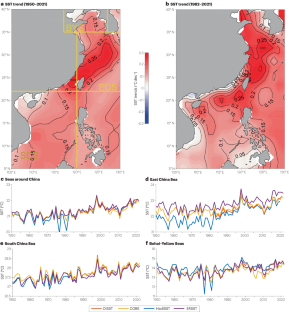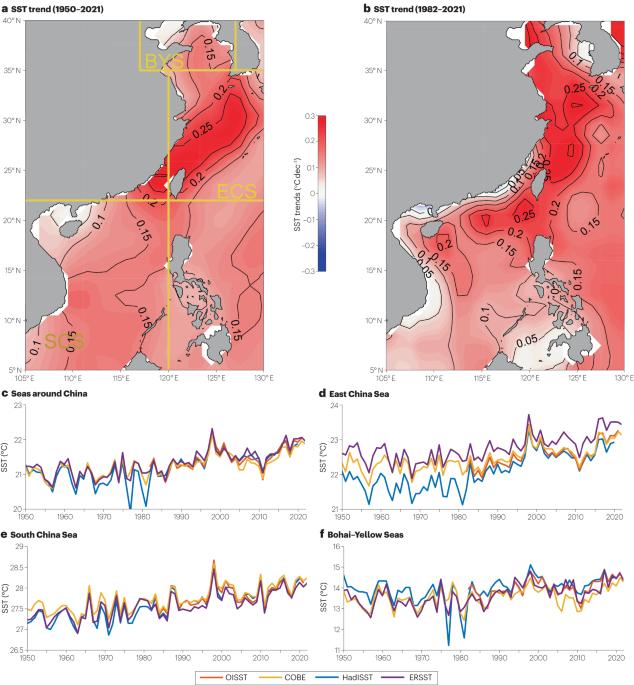The seas around China in a warming climate
引用次数: 0
Abstract
Anthropogenic forcings have led to multifaceted changes in the seas around China, which include the Bohai, Yellow, East China and South China Seas, affecting the functions and services they provide. In this Review, we synthesize physical, biogeochemical and biological findings to understand how the seas around China have changed and are projected to change under a warming climate. The average surface temperature of these seas increased by 0.10–0.14 °C dec–1 over 1950–2021. Meanwhile, the annual frequency and average intensity of marine heatwaves increased by 1–2 dec–1 and 0.1–0.3 °C dec–1 since the 1980s, respectively. Terrestrial input has increased nutrient concentrations and composition changes in coastal waters. These warming and nutrient changes have increased the severity of hypoxia and acidification, leading to complex changes in primary productivity. Changes to marine organisms such as plankton, benthos and fish are also apparent, including the northward invasion of warm-water species and miniaturization. These observed changes are projected to persist into the future. These coupled physical–ecological changes highlight the need for strengthened multidisciplinary oceanographic research in the seas around China. Increasing temperatures in the seas around China have a range of physical, biogeochemical and biological impacts. This Review outlines historical and projected changes in these seas and the implications of these changes for marine ecosystems.


气候变暖背景下的中国周边海域
人为作用力导致中国周边海域(包括渤海、黄海、东海和南海)发生了多方面的变化,影响了它们所提供的功能和服务。在本《综述》中,我们综合了物理、生物地球化学和生物学方面的研究结果,以了解在气候变暖的情况下,中国周边海域发生了怎样的变化以及预计会发生怎样的变化。在1950-2021年间,这些海域的平均表面温度上升了0.10-0.14°C dec-1。同时,自 20 世纪 80 年代以来,海洋热浪的年频率和平均强度分别增加了 1-2 dec-1 和 0.1-0.3 °C dec-1。陆地输入增加了沿岸水域的营养浓度和成分变化。这些变暖和营养物质的变化加剧了缺氧和酸化的严重程度,导致初级生产力的复杂变 化。浮游生物、底栖生物和鱼类等海洋生物的变化也很明显,包括暖水物种的北侵和小型化。预计这些观测到的变化将持续到未来。这些物理-生态耦合变化凸显了加强中国周边海域多学科海洋学研究的必要性。中国周边海域温度升高会产生一系列物理、生物地球化学和生物影响。本综述概述了这些海域的历史变化和预测变化,以及这些变化对海洋生态系统的影响。
本文章由计算机程序翻译,如有差异,请以英文原文为准。
求助全文
约1分钟内获得全文
求助全文

 求助内容:
求助内容: 应助结果提醒方式:
应助结果提醒方式:


